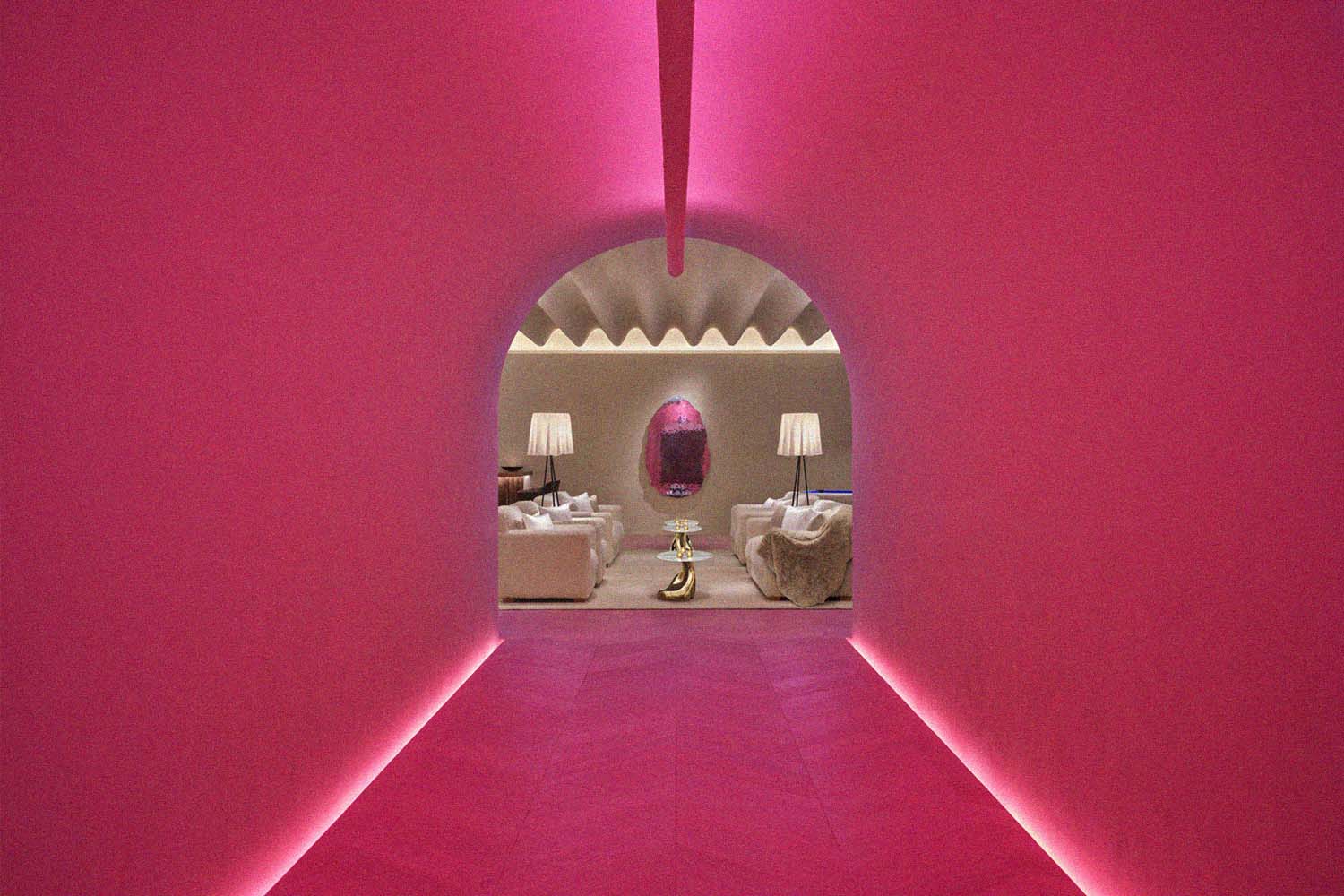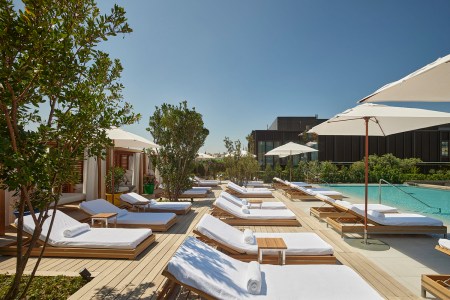Beyond its majestic architecture and must-see museums, the Spanish capital is also where you’ll find diverse barrios filled with cool bars, peaceful parks and tucked-away spots for in-the-know locals. Rich in history and culture, Madrid is much less tourist-focused than the capital of Spain’s Catalonia region. A mecca for fans of fine art, good food, afternoons enjoying “vermouth hour” plus plenty of non-stop nightlife, the cosmopolitan and sophisticated city has it all. Here’s how to make the most of your Madrid vacation.
Welcome to Madrid
After landing at Madrid–Barajas Airport, there are several ways to get into the city. Best for budget travel, the 24-hour Exprés Aeropuerto bus costs five euros and takes around 40 minutes. For a more elevated experience — especially when arriving on a red-eye — Black Lane can arrange private rides for seamless transfers with their chauffer service (about 70 euros each way) in top-of-the-line cars and EVs, including the Jaguar I-PACE and Tesla Model S.
Covid Requirements: U.S. citizens headed to Spain must show proof of current vaccination status or a negative test result within 72 hours (NAAT, RAT) or 24 hours (PCR) of departure.

Where to Stay in Madrid

A swanky place to see and be seen, The Madrid EDITION boasts the city’s biggest rooftop pool and whose fourth-floor perch is shared with much buzzed-about Pisco bar, Oroya. Below are 200 rooms and suites, some with private terraces, all decorated in a palette of chic whites and neutrals — from the sofas and faux fur throws, to flowering orchids. Bathrooms are stocked with full-sized Le Labo products in the signature EDITION black tea scent. Located in the lively Sol neighborhood, “Kilometre Zero” (the geographical center of Spain), Plaza Mayor, Gran Vía and the Royal Palace are within easy distance. With its inviting sofas and pool table hewn from a slab of white Bianco Neve marble, the Lobby Bar is a central hub for guests and locals reached by the oft-photographed floating EDITION staircase. The hotel is also home to Jerónimo, the first European restaurant from award-winning Mexican chef Enrique Olvera.
Day 1

Do: A fun way to get acquainted with a new city is by tasting some of its famous local dishes. The Neighborhood Market and Tapas Experience with Walk and Eat Spain introduces travelers to the Malasaña neighborhood and dives into Madrid’s history and Spanish food culture, but also provides a chance to meet chefs and Aperitivo experts. Start with breakfast at a century-old churrería, shop for cured meats at a local mercado and finish the day with a tapas lunch.
Pro Tip: A 7-Day Tourist Travel Pass is an easy and affordable way to get around Madrid using public transport, including blue city buses and the Metro, which runs from 6 a.m. to 1:30 a.m.


See: Spain’s most famous art form isn’t strictly from Madrid, but there are several places to catch flamenco around town, and Corral de la Morería is considered legendary. The owner is a big deal in the flamenco world, and it’s the only “tablao” with a Michelin-rated chef attached. Tickets for the nightly shows, with dinner or a drink, cost just under 50 euros. For set menus at the gastronomic space helmed by chef David García expect to pay between 60 and 80 euros.

Day 2:

See: The Prado, Reina Sofía Art Centre and Thyssen-Bornemisza Museum comprise Madrid’s “Golden Triangle,” but if you must only pick one, make it El Prado. Spanning 500 years of European art, it’s home to one of the finest collections in the world and includes over 2,000 pieces by iconic painters like Goya, Velázquez, Picasso and Dali. With so much to see (it would take days) if booked ahead, the museum’s one-hour guided tour (10 euros) is a great jumping-off point. Otherwise, plan to arrive when they open at 10 a.m. (to avoid wait times for tickets and getting through security) and grab a map, which includes a guide to all the Prado highlights.

Eat: Located around the corner from El Prado, the friendly neighborhood restaurant The Spanish Farm is a perfect pick for lunch, which usually starts around 2 p.m. in Madrid. Everything on the menu is super local and seasonal — mix and match dishes like the trio of artichoke flowers, burrata salad and confit duck drumsticks and pair with a nice bottle of Rioja.
The Hotel Hot List: Four Places to Stay Right Now in 2022
Destinations we’ve personally visited, and can vouch for, from Atlanta to Madrid
Stroll: What better way to walk off lunch than by walking around Madrid’s beautiful Royal Botanical Garden? Founded in 1755 by King Ferdinand VI but moved to its current site almost two decades later, more than 5,500 species of plants, trees, shrubs, herbs, and flowers, including a wild rose garden, from five continents can be found across its impressive 20 acres.

Drinks & Dinner: With a spot on the world’s 50 Best Bars list, Salmon Guru has become an in-the-know go-to as much for the cocktails (works of art) as its neon-lit interior (vibe: vintage liquor store meets 1960s New York club). The brainchild of master mixologist Diego Cabrera, tipples like Dragon Daughter are served in fantastical vessels (think tiki mugs, but extra). Come for the drinks, stay for some haute tapas like the spiced pork rolls and tonkatsu chicken sando.

Day 3:

Do: With its 3,000-plus lavish rooms, The Royal Palace of Madrid is an over-the-top example of Rococo architecture and old-world opulence. Reserved for state ceremonies, it remains the official residence of the Spanish royal family. To skip long wait times, especially on weekends, book tickets ahead of time but don’t miss seeing the Sabatini Gardens on the north façade. An Insta-gold moment at any time of the day, it’s one of the best places to catch the sunset.
Pro Tip: If two to three hours tops better suits your bandwidth for suits of armor and gilded thrones, admission to the palace is free between 4 and 6 p.m. Monday through Thursday. Plan to arrive around 3:30 p.m. to secure a place in line, last access for the day is granted at 5 p.m.

Eat: A short walk from Plaza Mayor in the Habsburgs District, Mercado de San Miguel dates to 1916 when it first opened as a food market. Today, the ornate cast iron-covered gourmet hub is home to over 30 tapas vendors selling everything from small plates of Iberian ham and fresh seafood to pizzas, artisan cheeses, olives and empanadas. Best paired with a glass of wine, Champagne, Vermouth or alcohol-free sangria. Open from 10 a.m. until midnight daily, seating options are limited during peak times, so plan to visit before or after the lunch rush.

La Hora del Vermut: A treasured tradition in Madrid, “the Vermouth hour,” was traditionally just before lunch (to prepare the palette) now it’s socially acceptable to enjoy the elegant Aperitivo at any time of day. Head to La Violeta and drink one like a local, with an orange slice, splash of soda water and a side of “gilda” tapas — pickles, anchovies, and olives on a skewer.
Day 4:

Day Trip: Madrid might be filled with culinary and artistic treasures, but the city also serves as a gateway to local towns and heritage sites within easy reach by train or tour bus.
The ancient city of Toledo is an easy day trip, but anyone keen to see the UNESCO World Heritage site, the windmills of Mota del Cuervo (that inspired Cervantes when writing his famous novel) and do a spot of wine tasting will love this small group Toledo Wine Tour by Wine Tourism Spain. For a deeper dive into La Mancha — the largest wine-producing region in the world — that includes a stop at 15th-century Belmonte Castle, a traditional lunch and two winery visits plus tastings, the La Mancha and Don Quixote Tour is another superb option.
Pro Tip: Check out Toledo on your own time and hop on an AVE high-speed train from Atocha station. They run every hour, take about thirty minutes to get there, and a ticket costs 14 euros.
Day 5:

Do: Beyond emblematic square and touristy Puerta del Sol, Madrid has many classy and cosmopolitan residential neighborhoods worth exploring. Salesas is home to the famous Café Gijón (see below), while the tree-lined avenues of Salamanca are where you’ll find Michelin-starred restaurants, high-end boutiques and stylish night spots on the “Golden Mile.”

Hang Out: Regarded as “the last literary café in Madrid,” Café Gijón was a mecca for writers and Hollywood stars from Hemingway and Orson Welles to Truman Capote and Ava Gardner. For literary fans, it’s deliciously historical, although recent reviews are spotty and the prices high. Stop by for a coffee or Aperitivo on the terrace with a side of people watching and call it good.

Eat: Glamorous Asian fusion restaurant Amazonico in Salamanca is lovely for lunch but truly comes alive at night — lush palm trees and faux peacocks add to the exotic ambiance, and dishes take inspiration from Japanese, Indian and Peruvian cuisine. For after dinner cocktails and live music, head to the ground-floor Jungle Jazz Club, which closes at 4 a.m.
Pro Tip: Check the schedule to see when Real Madrid CF (the world’s most valuable football club in 2022, per Forbes) is playing a home game at the Santiago Bernabéu Stadium. If dates don’t align, tours that include a visit to the museum and official shop can be booked instead.

Day 6:

Eat: Wander up the street from the EDITION to legendary La Mallorquina for coffee and a morning pastry. Established in 1894, it’s one of the oldest pastelerías in Madrid and something of an institution, so the lines can get long. Be prepared to order in Spanish and grab and go from the counter or head upstairs for table service in the café which enjoys views of Plaza del Sol.

Do: With some of the best shopping in Spain, Madrid’s main thoroughfare Gran Vía is where to find high-street favorites like Mango and Massimo Dutti, along with Spanish luxury fashion house Loewe. There are several branches of department store El Corte Inglés across the city, but only one Galería Canaleja, a brand-new luxury shopping destination in a neo-Baroque building less than five minutes from Puerta del Sol. For souvenirs you won’t find stateside, Pez Casa and COCOL have lovely handmade local goods and accessories. Other spots worth a look-see include Pez Tienda and Despacio Concept Store. Madrid is also awash with cool vintage clothing stores, especially around Malasaña, where Templo de Susu is located.

Drink: Stop by The Principal Madrid Hotel for cocktails, sushi and live music during a Sunset Session on La Terraza, which enjoys fantastic skyline views over Gran Vía and beyond. For inspired Mediterranean dishes with Spanish flair, stay for dinner at signature restaurant, Ático.

Day 7:

Do: A gorgeous green space within the city where you’ll spy sculptures, a picturesque lake and volunteers feeding friendly resident cats, UNESCO World Heritage site Retiro Park is a popular spot among Madrileños to stroll, socialize, play a game of petanca and jog the 2.5-mile loop that edges the 350-acre site. It’s also home to Palacio de Cristal (the “Glass Palace”), which doubles as a contemporary art gallery. After a late morning walk, head back to the hotel for a steam and sauna, followed by a treatment at The EDITION Spa and a chilled afternoon by the rooftop pool.

Eat: After staying at one of the city’s newest hotels all week, balance things with a farewell dinner at its oldest restaurant. Established in 1725 by a French cook, Botín is famous for its roast suckling pig — a favorite of Hemingway, who mentions it in “The Sun Also Rises” and “Death in the Afternoon.” It’s a tourist spot, not a hidden gem, but the chance to eat at the world’s oldest restaurant makes it a must-do in Madrid. Reservations (first tables are seated at 8 p.m. and the last at 11:15 p.m.) are essential, though, and can be made on the website.
For more travel news, tips and inspo, sign up for InsideHook's weekly travel newsletter, The Journey.






















